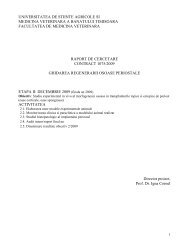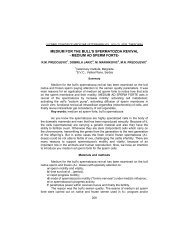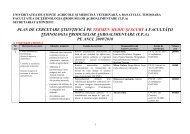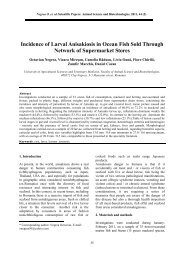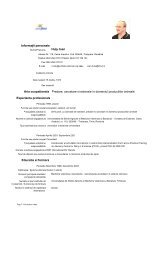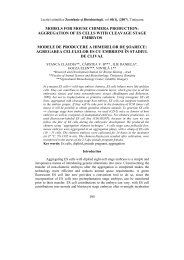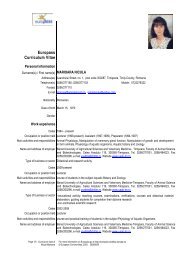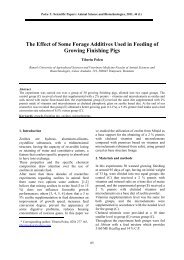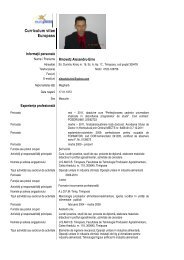journal of linguistic studies
journal of linguistic studies
journal of linguistic studies
Create successful ePaper yourself
Turn your PDF publications into a flip-book with our unique Google optimized e-Paper software.
houndstongue (R limba câinelui); viper’s bugloss (R viperină); common storksbill (R<br />
ciocul berzei with the variant ciocul-cucoarei) – we find the same Romanian translation<br />
for cut-leaved crane’s-bill/bloody crane’s-bill, crane meaning cocor/cucoara in<br />
Romanian; bird’s-foot trefoil (R unghia-găii – gaie is chough, a bird related to the crow),<br />
dog’s mercury (R buruiană câinească); bird’s-nest orchid (R cuibul rândunelii), bee<br />
orchid (R albină), lousewort (R păducherniţă), cowslip (R ţâţa vacii with the variant<br />
ciuboţica cucului, cuc meaning ‘cuckoo’), goatsbeard (R barba caprei, ţâţa caprei),<br />
common horsetail as well as water horsetail, wood horsetail and mare’s tail (R coada<br />
calului, with the variants barba ursului, urs meaning ‘bear’, and coada iepei, iapă<br />
meaning ‘mare’).<br />
As for the idioms containing other animal names, we have: oyster fungus (R păstrăv<br />
de fag – păstrăv meaning ‘trout’, still an aquatic animal but from another phylum);<br />
stagshorn clubmoss (R brânca ursului/barba ursului – urs meaning ‘bear’); horse<br />
chestnut (R castan porcesc – instead <strong>of</strong> horse we find porc ‘pig’, still a mammal, but<br />
again a different order); alder buckthorn (R lemn câinesc – instead <strong>of</strong> buck we have câine<br />
‘dog’); black horehound (R urechea porcului – again the animal name in Romanian is<br />
‘pig’, a mammal but from another order), common duckweed (R linte broştească where<br />
‘duck’ is replaced by broască ‘frog’, animals from different phyla).<br />
There are also instances where the Romanian common plant does not include an<br />
animal name (e.g. wolf-fart puffball R pufai, turkey tails R iască, stagshorn clubmoss R<br />
pedicuţă, dogwood R sânger, cowberry R merişor, smirdar, afin roşu, afin, coacăz de<br />
munte, gooseberry R agriş, sea buckthorn R cătină albă, crab apple R măr pădureţ, bird<br />
cherry R mălin negru, dog rose R cacadâr, măceş, răsură, rujă, rug sălbatic, trandafir<br />
sălbatic – even though there are several Romanian names, none <strong>of</strong> them contains a colour<br />
name, etc).<br />
A last category <strong>of</strong> English common plant names containing colour names is the one <strong>of</strong><br />
such names where we did not find a Romanian common name: frog orchid, pignut,<br />
horseshoe vetch, monkey flower, fly orchid, greater butterfly orchid, common watercrowfoot,<br />
etc.<br />
We also found 56 Romanian common plant names containing an animal name.<br />
Although all had an English counterpart, none <strong>of</strong> the English equivalents contained an<br />
animal name (e.g. R buretele viperei – death cap; R pita vacii – cep; R băşina calului –<br />
giant puffball; R păstrăv de pădure – peppery milk cap; R pălăria-şarpelui, burete<br />
şerpesc – parasol mushroom; R băşica porcului – puffball; R burete păstrăv – dryad’s<br />
saddle; R spinarea lupului – lady fern; R coada rândunicii – liverwort; R cerga ursului –<br />
bracken; R struţişori – lesser clubmoss; R coada-mâţei-de-baltă – sphagnum moss; R<br />
lemnul câinelui – spindle tree; R porumbel – blackthorn; R coada şoricelului – yarrow; R<br />
ochiul lupului, limba-boului – bugloss; R oiţe – wood anemone; R porumbul şarpelui –<br />
lords and ladies; R iarba limbricilor – milk vetch; R cireaşa lupului – deadly nightshade;<br />
R guşa porumbelului – bladder campion). However two <strong>of</strong> them contained animal body<br />
parts (R copita calului – ho<strong>of</strong> fungus; R untul vacii – green winged orchid, lady orchid).<br />
As for the animal names in the Romanian common plant names we analysed, they range<br />
from insects (e.g. iarba limbricilor – the animal name used here is ‘round worm’) to fish<br />
(e.g. limba peştelui the animal name used here is ‘fish’) amphibians (e.g. izma-broaştei –<br />
the animal name used here is ‘frog’), reptiles (e.g. buretele viperei – the animal name<br />
used here is ‘viper’), to birds (e.g. coada rândunicii - the animal name used here is<br />
‘swallow’) and mammals (e.g. ţolul lupului – the animal name used here is ‘wolf’).<br />
27



